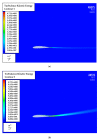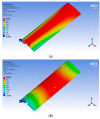Aerodynamic Analysis of Camber Morphing Airfoils in Transition via Computational Fluid Dynamics
- PMID: 35645179
- PMCID: PMC9149911
- DOI: 10.3390/biomimetics7020052
Aerodynamic Analysis of Camber Morphing Airfoils in Transition via Computational Fluid Dynamics
Abstract
In this paper, the authors analyze an important but overlooked area, the aerodynamics of the variable camber morphing wing in transition, where 6% camber changes from 2% to 8% using the two airfoil configurations: NACA2410 and NACA8410. Many morphing works focus on analyzing the aerodynamics of a particular airfoil geometry or already morphed case. The authors mainly address "transitional" or "in-between" aerodynamics to understand the semantics of morphing in-flight and explore the linearity in the relationship when the camber rate is gradually changed. In general, morphing technologies are considered a new paradigm for next-generation aircraft designs with highly agile flight and control and a multidisciplinary optimal design process that enables aircraft to perform substantially better than current ones. Morphing aircraft adjust wing shapes conformally, promoting an enlarged flight envelope, enhanced performance, and higher energy sustainability. Whereas the recent advancement in manufacturing and material processing, composite and Smart materials has enabled the implementation of morphing wings, designing a morphing wing aircraft is more challenging than modern aircraft in terms of reliable numerical modeling and aerodynamic analysis. Hence, it is interesting to investigate modeling the transitional aerodynamics of morphing airfoils using a numerical analysis such as computational fluid dynamics. The result shows that the SST k-ω model with transition/curvature correction computes a reasonably accurate value than an analytical solution. Additionally, the CL is less sensitive to transition near the leading edge in airfoils. Therefore, as the camber rate changes or gradually increases, the aerodynamic behavior correspondingly changes linearly.
Keywords: CFD; airfoil; analytical and numerical; benchmark; camber morphing; computational fluid dynamics; transition.
Conflict of interest statement
The authors declare no conflict of interest.
Figures


























References
-
- Miller G.D. Active Flexible Wing (AFW) Technology. Rockwell International Los Angeles Ca North American Aircraft Operations; Fort Belvoir, VA, USA: 1988.
-
- Anderson J.D., Bowden M.L. Introduction to Flight. Mc Graw Hill; New York, NY, USA: 2005.
-
- Barbarino S., Bilgen O., Ajaj R.M., Friswell M.I., Inman D.J. A review of morphing aircraft. J. Intell. Mater. Syst. Struct. 2011;22:823–877. doi: 10.1177/1045389X11414084. - DOI
-
- Martin C., Kudva J., Austin F., Jardine A., Scherer L., Lockyer A., Carpenter B. Smart Materials and Structures-Smart Wing Volumes I, II, III, and IV. Northrop Grumman Corporation; Hawthorne, CA, USA: 1998. Report: AFRL-ML-WP-TR-1999-4162.
-
- Weisshaar T.A. Morphing Aircraft Technology-New Shapes for Aircraft Design. Defense Technical Information Center; Fort Belvoir, VA, USA: 2006.
Grants and funding
LinkOut - more resources
Full Text Sources
Miscellaneous

